
Resistance Training for Health
This approach is gaining attention for its potential in alleviating work-related pain among oral health professionals.
Dental hygienists and dentists experience a high prevalence of musculoskeletal disorder (MSD)-related pain, which is often a result of repetitive movements and excessive overloading of the affected muscle group. Oral health professionals most frequently experience MSD-related pain in the wrist/hands (69%), neck (68%), shoulders (60%), upper back (67%), and lower back (57%); work-related discomfort is less prevalent in the lower extremities.1–3
Ergonomic training, stretching, and yoga are often advised to prevent the onset of MSD-related pain.4 While resistance training has not been fully explored as a solution to preventing MSD-related pain, some positive results have been noted among individuals.3,5–8 As such, resistance training may offer an additional strategy for oral health professionals who wish to reduce their risk of MSD-related injuries.
Wrist and Hand Pain
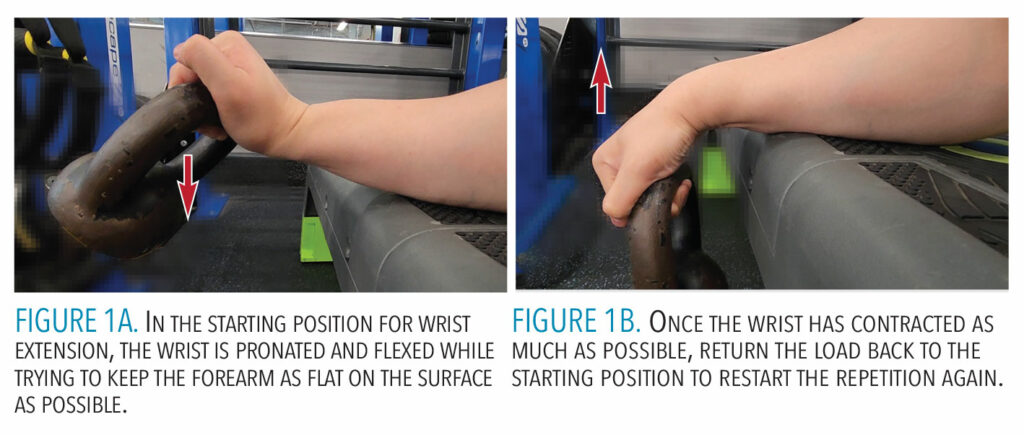 Wrist and hand pain are the most common types experienced by dental hygienists due to the repetitive nature and excessive grip forces used during hand instrumentation.1,2,5–7 To strengthen their wrists, dental hygienists can try wrist extension and flexion exercises. Before initiating any exercise program, it is prudent to consult with one’s primary care provider.
Wrist and hand pain are the most common types experienced by dental hygienists due to the repetitive nature and excessive grip forces used during hand instrumentation.1,2,5–7 To strengthen their wrists, dental hygienists can try wrist extension and flexion exercises. Before initiating any exercise program, it is prudent to consult with one’s primary care provider.
Figures 1 and 2 demonstrate these exercises performed with kettlebells. For wrist extension, the load is grasped with a pronated hyperflexed wrist, the ventral of the forearm placed on a flat surface for leverage, and load hanging off the surface. The dental hygienist should then extend his/her wrist upward while keeping the forearm as flat as possible on the surface, as demonstrated in Figure 1A. Once the apex of the movement has been reached, or the load has moved as much as comfortably possible (Figure 1B), the dental hygienist should then slowly lower the weight down back to the starting position (Figure 1A) so that another repetition may be initiated.
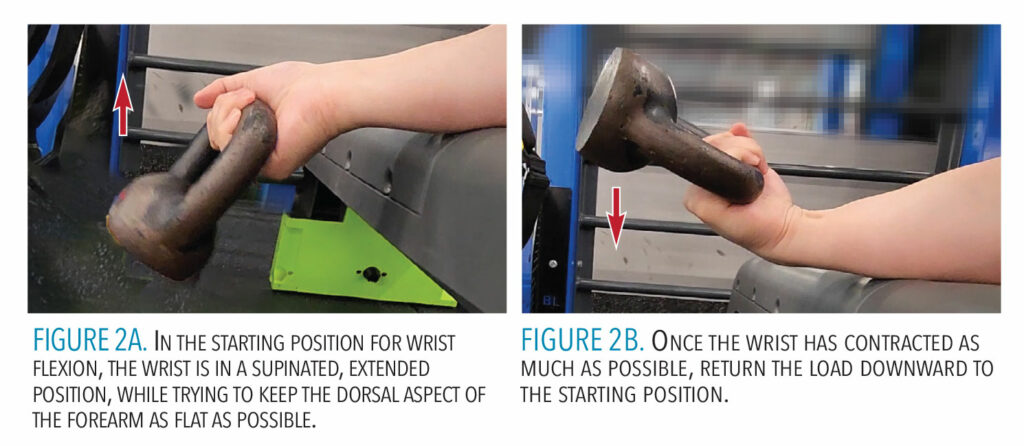 Figures 2A and 2B (page 16) demonstrate forearm flexion. In this exercise, the wrist is supinated, and the dorsal of the forearm should be laying flat on the surface with the load grasped and the wrist in extension, as in Figure 2A. Initiate the movement by flexing the wrist upward, once the full range of motion has been achieved (Figure 2B), lower the load back down to the start position, and another repetition may be initiated.7 These exercises can also be performed at home using dumbbells or resistance bands.
Figures 2A and 2B (page 16) demonstrate forearm flexion. In this exercise, the wrist is supinated, and the dorsal of the forearm should be laying flat on the surface with the load grasped and the wrist in extension, as in Figure 2A. Initiate the movement by flexing the wrist upward, once the full range of motion has been achieved (Figure 2B), lower the load back down to the start position, and another repetition may be initiated.7 These exercises can also be performed at home using dumbbells or resistance bands.
Research shows that study participants who regularly performed these exercises increased grip strength and noted a decrease in their self-rated pain perception of up to 40%.5,7
Neck and Shoulder Pain
 Dental hygienists are at risk for pain in the neck and shoulder areas due to the strenuous neck positions required during patient care such as needing to hold a static position for extended periods and performing tasks that cause excessive flexion of the neck.1–3 Both of these scenarios create a disproportionate load on the clinician’s neck and, over time, may cause chronic MSD-related pain.
Dental hygienists are at risk for pain in the neck and shoulder areas due to the strenuous neck positions required during patient care such as needing to hold a static position for extended periods and performing tasks that cause excessive flexion of the neck.1–3 Both of these scenarios create a disproportionate load on the clinician’s neck and, over time, may cause chronic MSD-related pain.
To strengthen the neck, dental hygienists may try forward and backward bending of neck (extension [Figure 3, page 16] and flexion) and lateral bending while under load.8 In Figure 3A, the dental hygienist is using a neck harness to help ensure the muscles of the neck are responsible for the movement of the load. In this case, the weight is hanging from the harness, requiring the neck to be in full flexion. From this position, the dental hygienist begins to extend the neck in a cranial direction until it is relatively upright, while making sure not to hyperextend the neck. Once the neck is upright, the dental hygienist should slowly lower his/her head back into the starting position, in a slow and controlled manner and another repetition may be initiated.
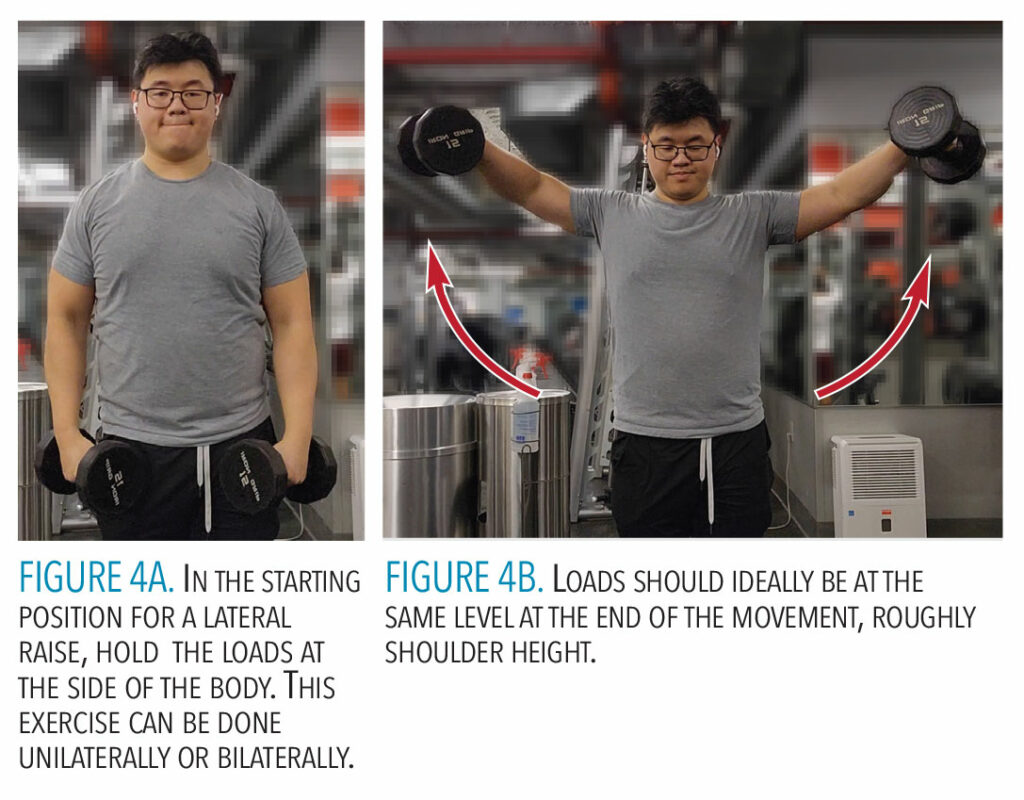 Shoulder pain can be attributed to unsupported or improper arm positioning during scaling as well as the increased usage of computers in the dental setting.2 Lateral raises, front raises, and rows can be used to increase shoulder strength.3,8,9 Figure 4A displays the start position of a lateral raise. Dental hygienists should hold the load, in this case the dumbbells, at their side. To initiate the movement, raise the load(s) laterally, making sure to keep the arm as straight as possible, as demonstrated in Figure 4B. This exercise can be done either with one or both arms at a time. Once the weight has reached around shoulder height, the dental hygienist may begin to lower the load down back to the starting position.
Shoulder pain can be attributed to unsupported or improper arm positioning during scaling as well as the increased usage of computers in the dental setting.2 Lateral raises, front raises, and rows can be used to increase shoulder strength.3,8,9 Figure 4A displays the start position of a lateral raise. Dental hygienists should hold the load, in this case the dumbbells, at their side. To initiate the movement, raise the load(s) laterally, making sure to keep the arm as straight as possible, as demonstrated in Figure 4B. This exercise can be done either with one or both arms at a time. Once the weight has reached around shoulder height, the dental hygienist may begin to lower the load down back to the starting position.
When introducing resistance training protocols to professionals with neck and shoulder MSD-related pain, participants also experienced a decrease in perceived pain in each of the target areas along with increased measures of strength.8,9
Upper and Lower Back Pain
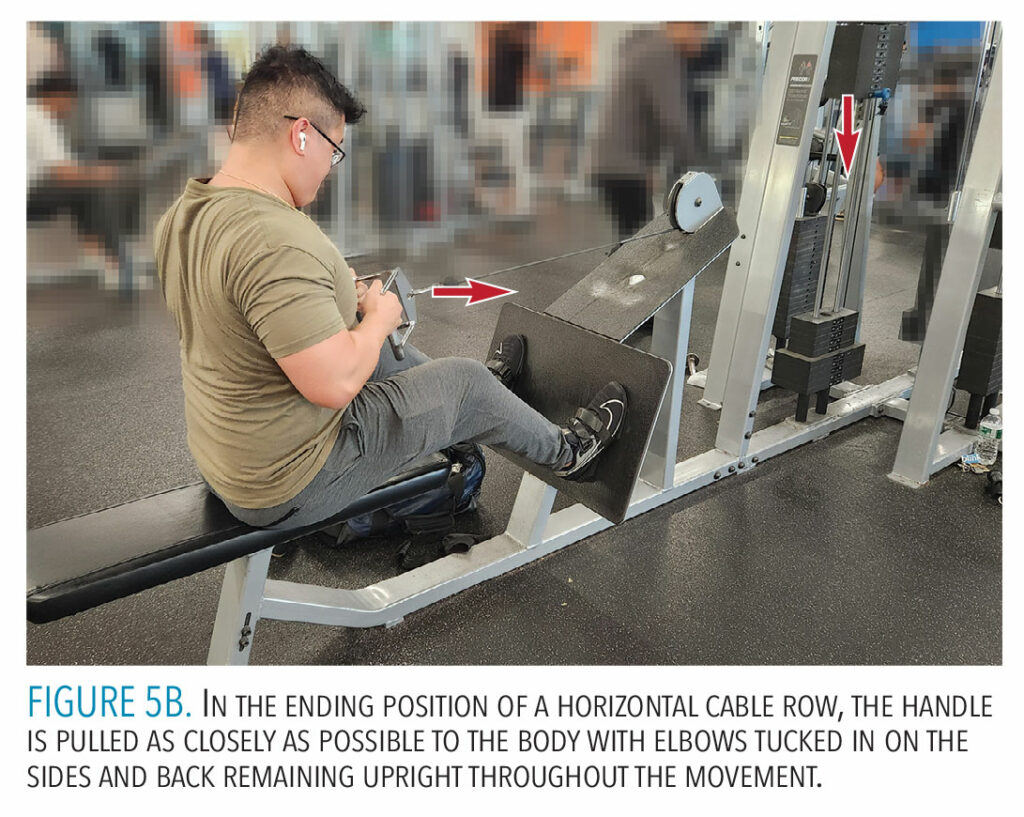
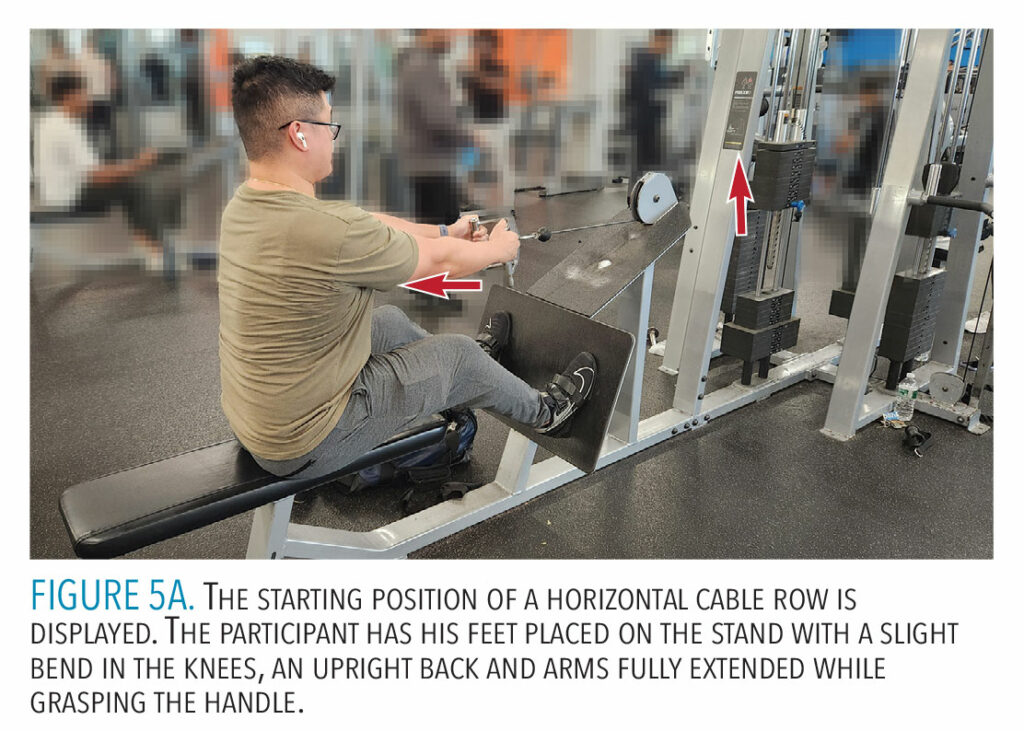 MSD-related pain is also common in the muscles of the upper and lower back due to dental hygienists’ need to maintain a static positions for extended periods.2,3,8,9 This pain is compounded by the unilateral bending and twisting of the trunk required during the provision of treatment.3 Rows, hyperextensions, and trunk rotations may help reduce upper- and lower-back pain.
MSD-related pain is also common in the muscles of the upper and lower back due to dental hygienists’ need to maintain a static positions for extended periods.2,3,8,9 This pain is compounded by the unilateral bending and twisting of the trunk required during the provision of treatment.3 Rows, hyperextensions, and trunk rotations may help reduce upper- and lower-back pain.
To complete a horizontal cable row, dental hygienists should be seated upright on the bench portion of the machine with their feet flat on the stand, a slight bend in their legs, while holding the handle as in Figure 5A. In order to initiate the exercise, dental hygienists should bring the handle close to their bodies by pulling the handle with their arms, while making sure to keep their elbows tucked into their sides and with their backs upright, causing the stack of weights to move upward, ending up in a similar position as demonstrated in Figure 5B. Once the handle is pulled in as much as possible, slowly let the handle return to the initial position, lowering the stack of weights. This movement is more focused on the muscles of the upper-back, and as mentioned earlier, it does help strengthen the (posterior) muscles of the shoulder. 3,8,9
 In Figures 6A and 6B, the dental hygienist is using a hyperextension machine to carry out back extensions. When positioning in the machine, individuals should adjust the height of the upper padded area so that the top of their hip is at or slightly below the top of the pad. Both feet should also be secured under the bottom padded portion. To initiate the exercise, participants should think about using their hip and the pad as a hinge and extend their lower back and hips in order to raise their torso. Dental hygienists should try to extend their torso so that it is parallel with their hip as demonstrated in Figure 6B, making sure not to hyperextend past that point.
In Figures 6A and 6B, the dental hygienist is using a hyperextension machine to carry out back extensions. When positioning in the machine, individuals should adjust the height of the upper padded area so that the top of their hip is at or slightly below the top of the pad. Both feet should also be secured under the bottom padded portion. To initiate the exercise, participants should think about using their hip and the pad as a hinge and extend their lower back and hips in order to raise their torso. Dental hygienists should try to extend their torso so that it is parallel with their hip as demonstrated in Figure 6B, making sure not to hyperextend past that point.
Oral health professionals who followed resistance training protocols specifically targeting the muscles of the upper and lower back exhibited increased strength of the targeted muscles with decreased pain after receiving the training.3, 8–10
Contraindications
While the data are promising regarding resistance training’s effectiveness in reducing MSD-related pain, risks do exist. In the research, clinicians are supervised by trained specialists who make sure participants performed the exercises correctly.3,5–8 There is a risk of injury if exercises are done excessively, without proper form, or with too heavy a load.10
Compliance with resistance training protocol is another challenge. In studies, the dropout rate hovers around 15% to 20%.5–7,9 Resistance training protocols will only be effective if dental hygienists adhere to them consistently. Lack of time and strenuous nature of the exercises have been noted as reasons for poor compliance.
Comparison of Efficacy
When compared to other ergonomic approaches, researchers have found that a resistance training intervention provided more significant reductions in self-perceived pain than an ergonomic training intervention alone.5 Another study found that participants who used stretching and resistance training together vs resistance training alone had a greater decrease in pain perception and a higher increase in measures of strength when compared to the resistance training-only group.11
Conclusion
Some research supports the role of resistance training in decreasing the onset of MSD-related pain.3,5–10 Because MSDs are multifactorial, more research should be done on how resistance training may be used to prevent/delay the onset of MSD-related pain and, ultimately, improve the career longevity of dental hygienists.
References
- Netanely S, Luria S, Langer D. Musculoskeletal disorders among dental hygienist and students of dental hygiene. InJ J Dent Hyg. 2020;18:210-216.
- Holzgreve F, Fraeulin L, Maurer-Grubinger C, et al. Effects of resistance training as a behavioural preventive measure on musculoskeletal complaints, maximum strength and ergonomic risk in dentists and dental assistants. Sensors. 2022;22(20):N.PAG.
- Owen J, Kearney R. Stretch for health. Dimensions of Dental Hygiene. 2023;21(1)16-18.
- Sundstrup E, Jakobsen MD, Brandt M, Jay K, Aagaard P, Andersen LL. Strength training improves fatigue resistance and self-rated health in workers with chronic pain: a randomized controlled trial. BioMed Res Int. 2016;2016:1–11.
- Pedersen MT, Andersen CH, Zebis MK, Sjøgaard G, Andersen LL. Implementation of specific strength training among industrial laboratory technicians: long-term effects on back, neck and upper extremity pain. BMC Musculoskelet Disord. 2013;14:287.
- Gobbo S, Bullo V, Roma E, et al. Effects of Tailored resistance exercise training in a group of metalworkers with ergonomic or manual handlings loads prescription by the occupational physician: a pilot study. Muscles, Ligaments & Tendons J. 2021;11:186-192.
- Dalager T, Welch A, O’Leary SP, Johnston V, Sjøgaard G. Clinically relevant decreases in ne/k/shoulder pain among office workers are associated with strength training adherence and exercise compliance: explorative analyses from a randomized controlled trial. Phys Ther. 2022;103:2.
- Lidegaard M, Jensen RB, Andersen CH, et al. Effect of brief daily resistance training on occupational neck/shoulder muscle activity in office workers with chronic pain: randomized controlled trial. BioMed Res Int. 2013;2013:262386.
- Grier T, Brooks R, Solomon Z, Jones B. Injury risk factors associated with weight training. J Strength and Cond Res. 2022;36:e24-e30.
- Alex B, Varadharajulu G. Effectiveness of strengthening vs strengthening with stretching in individuals with nonspecific low back pain. Indian J Forensic Med Tox. 2020;14:141-145.
From Dimensions of Dental Hygiene. Jan/Feb 2024; 22(1):14-17

